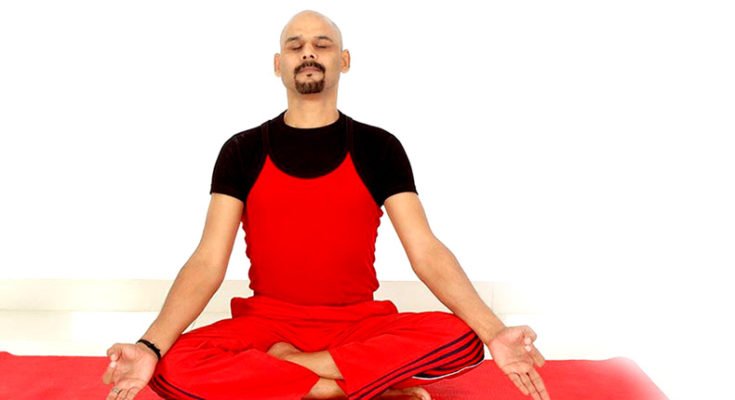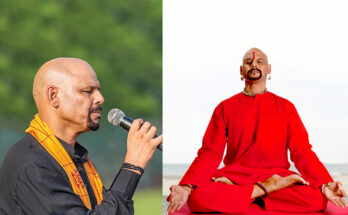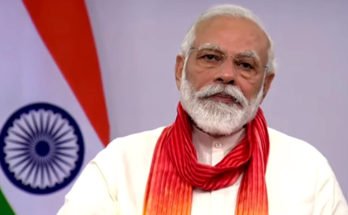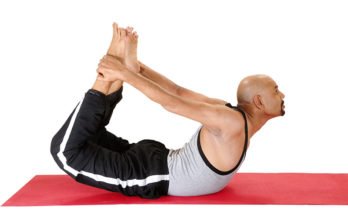Om Mantra Dhyan demonstrated by Yogaguru Suneel Singh. Image Courtesy – Vijay Gautam.
Worldwide, there are at least 44 million people living with Alzheimer’s and other dementias. It is found in at least 1 among 10 persons who are more than 80-year-old and 1 out of 4 persons who are above 90 years. In India, there are nearly 50 lakhs dementia patients; of which, roughly 70 to 80 per cent have Alzheimer’s. The Indian numbers are expected to double by 2030, and the costs involved are expected to increase three times. Everyone who has a brain is at risk to develop Alzheimer’s — but everyone can help to fight it. Now, this is the time to get involved. Together we can end Alzheimer’s.
Alzheimer’s disease (AD) is the most common type of dementia, in which the mental ability of persons gradually declines and reaches a stage where it becomes difficult for them to lead a normal life. With the disease progressing gradually, patients find themselves more and more dependent on their immediate family members for survival.
The most striking feature of AD is the loss of short-term memory among patents. It starts as minor forgetfulness and progresses into a disorder in which persons can’t even identify their near and dear ones. Patients lose both visual and verbal memories such as forgetting telephonic conversations, names of recent acquaintances, misplacing objects and losing way in known surroundings.
What is Alzheimer’s disease?
Alzheimer’s disease affects the nerve cells in the brain, causing their degeneration. In such circumstances, the brain loses the ability to analyze and use incoming-data that leads to a loss of independence, loss of memory and orientation in the environment. Usually, people over 65 years suffer from this disease, but occasionally people up to 50 years old can have it.
Symptoms of Alzheimer’s disease
Disability to evaluate events, sudden mood swings, Anxiety and depression and Loss of sense of time.
Causes of Alzheimer’s disease
Currently conventional medicine does not have precise data about the cause of Alzheimer’s disease. Presumably, causes are repeated vascular cerebral seizures, genetic predisposition, lack of fatty acids (especially essential ones), estrogen deficiency, frequent stresses etc.
Yoga has emerged as one of the most preferred alternative treatments by those who suffer from Alzheimer’s. Yoga is an ancient art that helps bringing a balance between the body and the mind. It has been seen that elderly people who practice yoga can keep their minds sharper.
People who practice yoga are able to bring balance to their lives. They are also able to keep their minds employed. Meditative techniques of yoga can help improve concentration as well as the ability to use the mind in an optimum manner. These key features of yoga therefore make it a very viable strategy for coping with and fighting Alzheimer’s.
Similar Topic: Yoga to defy Aging
1. Om Mantra Dhyan: Sit in Padmasana or Sukhasana. Keep the head and spine straight and upright and place the hands on the knees in Jyana Mudra. Close the eyes and relax the whole body. Repeat “Aum” loudly. In two steps of deep sounds of 0000 followed by “mmmm”.
Let the body be saturated with the sound of “Aum”. Daily do it for minimum 10 times.
Benefits: Padamasana or Sukhasana provide a firm base and a triangular path to contain the flow of ‘pran’. Om meditation is ‘nirigina’ meditation. Om sound is a form of energy made up of certain vibration have the power to heal. Om mantra is the root of all the sounds. Repeating Om relaxes every atom in your body.
2. Halasana (Plough Pose): Lie flat on your back with legs straight on the floor feet together and toes pointing. Relax the body slowly raise your legs from the ground keeping both feet together. Try to touch the toes to the floor behind the head. Do not force the toes to touch the floor, place the arms on the floor with palms facing down. Breathing should be normal, stay in the posture for as long as is comfortable, then slowly lower your legs on the floor pressing your elbows, and hands down. The head should rest on the floor. Relax in ‘Shavaasana’. Normalize your breathing.
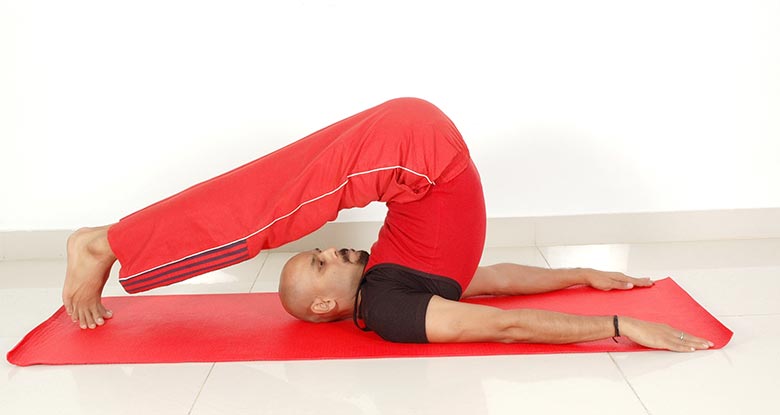
Halasana demonstrated by Yogaguru Suneel Singh.
Benefits: This asana improves liver and kidney functions. This asana influences thyroid gland, which balances the metabolic rate and the thymus gland, which strengthen the immune system.
Caution: Those suffering from High Blood pressure, hernia, slipped disc, sciatica or any other back problem avoid this.
Similar Topic: Yogic cure for Thyroid
3. Dhanurasana (Bow Pose): Lie flat on your stomach, with the legs and feet together and the arms and hands beside the body. Bend the knees and bring the heels close to the buttocks. Place the chin on the floor clasp the hand around the ankles. Take a deep breath and raise your head, trunk and legs above the ground in order to left legs, pull hands and legs in opposite direction support the entire body on the floor. Hold the position for as long as is comfortable and then slowly relaxing the leg muscles lower the legs, chest and head to the starting position. Do it minimum 3 times daily.
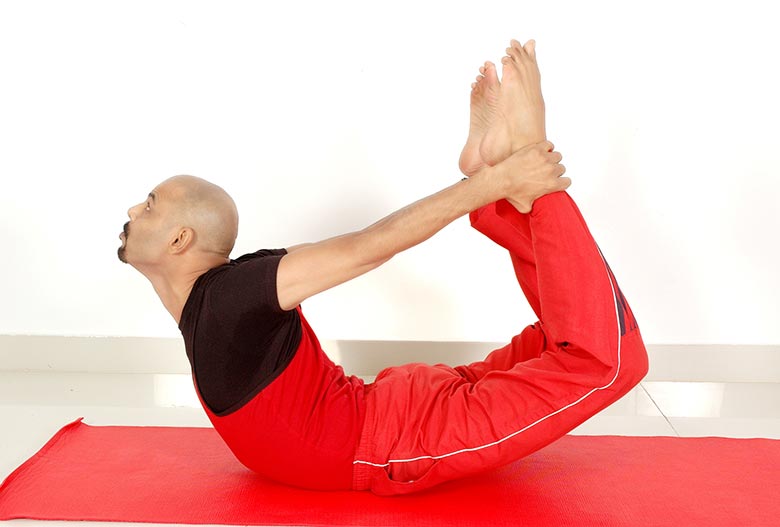
Dhanurasana (Bow Pose).
Benefits: This asana helps to improve digestion by stimulating gastric secretions. The liver, abdominal organ and muscles are massaged. This asana is recommended for the management of diabetes, menstrual disorders and neck pain.
Caution: Patients of colitis, hernia and slipped disc should avoid this asana. Heart patients and hyper tension patients should avoid this asana also.
Similar Topic: Yogic ways to control Obesity
4. Bhramari Pranayama: Sit in Padmasana or Sukhasana the spinal cord should be erect. The word Bhramari means bee. Because a sound is produced this imitates black bee. Keep your eyes gently closed. Now plugging your ears with thumbs, covering the eyes with the index and middle fingers the ring finger below the nostrils and the little fingers on the chin near the lips now breathe in through the nose. Exhale slowly and in a controlled manner while making a deep study humming sound like that of the black bee. Try to prolong the exhalation and humming sound as much as possible. This is one round to practice 10 rounds in the beginning and then increase the practice according to the time.
Benefits: Brahmari pranayam are Ram ban for snoring. It relieves stress and cerebral tension, alleviating anger, anxiety and insomnia. And it is excellent for alleviating diseases of throat, neck, nose, ears, eyes and mouth.
Exercise (Walking): Walking is an aerobic exercise that conditions the heart and lungs if performed at the proper intensity for 30-40 minutes at a time. Do it at least 3 to 4 times week.
Benefits: Increases your energy level, relieves tension, increases stamina, Tones the muscles, increases your resistance to fatigue and improves your self-image also.
5. Kurmasana: The way a tortoise pulls all his organs together within the body. Similarly, this asana is practiced, that is why it is called Kurmasana. Fold your feet and keep them apart at the back with toes together. Sit on the ankles spread apart. In this stage the knees will be together and the waist and neck will be straight. Thereafter make fists of both hands with thumbs with in fists will be facing sky. Unite both the elbows together and place them on the navel. Then while exhaling bend as much that the chest touches the arms. The back should not be raised from the heels.
Benefits: When a tortoise draws its limbs all sides, it withdraws its senses from the object of sense, and then its understanding is well poised. Its continuous practice is efficacious in many diseases of the stomach, constipation, gastric trouble, and indigestion.
Caution: People who suffer from slipped disc or sciatica, H.B.P and heart problems should not practice this asana.
6. Pawanmuktasana: Lie down on the back with both ankles and toes together. Fold the knee of the left foot and lift it up towards the chest. Then with both hands fold the knee between both elbows push the knee towards the chin and look straight. In this state the other feet will remain straight similarly practice it on the other leg then on both the legs together. Then both legs should be folded between both arms and place the knees on the chin and look straight ahead. Do it three times with each leg.
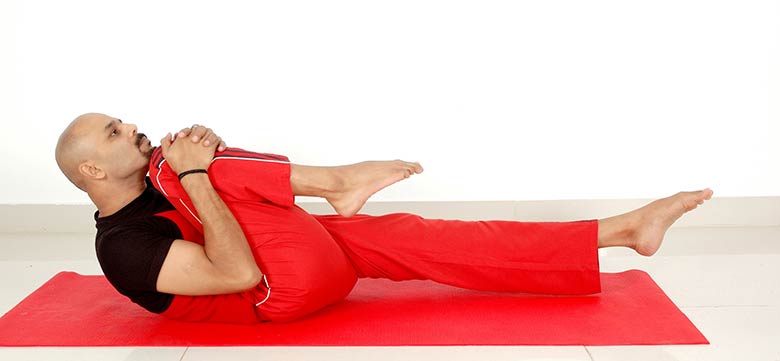
Pawanmuktasana posture 1.
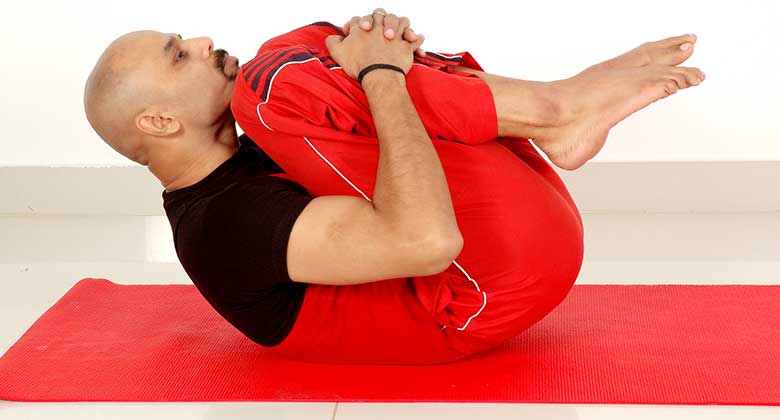
Pawanmuktasana posture 2.
Benefits: This asana cures knee pain and arthritis. It massages the digestive organs and is therefore very effective in removing wind and constipation. This asana also massages the pelvic muscles and alleviates impotence, sterility and menstrual problem.
Caution: People who suffer from slipped disc or sciatica should not practice Pawanmuktasana.
7. Sarvangasana: Lie down on the back and relax completely. Slowly raise the legs, hips and trunk in a continuous movement until vertical. Raise the legs – keeping the knees straight and hips by supporting the arms on the ground then bend the elbows and hold the trunk in the hand. In this posture the chin in buried in the upper chest. Retain the position as long as it is comfortable. Then come down slowly. Relax do it only once.
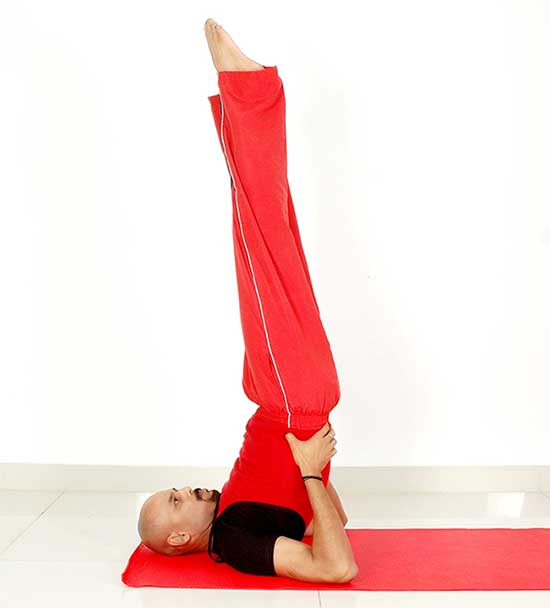
Sarvangasana.
Benefits: Blood supply to the organs in the upper part of the body such as eyes, heart, face, thyroid, roots of spinal nerves and brain. As a result circulatory congestion is relived and hormones flow into blood freely. This asana used in yoga therapy for the treatment of Asthma, Diabetes, Colitis, Alziemer, Thyroid disorders, Impotence and Menopause.
Caution: Those suffering from High B.P, Heart Ailments, Cervical pain and slipped disc should refrain from doing this asana.
8. Surya Bhedi Pranayama: Sit down in Padamasana or Sukhasana keeping the neck and spine erect, close your eyes gently. Now make pranayam mudra (placing the two forefinger of the right hand in the root of thumb, close the left nostril with the ring finger). Inhale deeply, through the right nostril so much that its impact is felt from the toe to the top of the crown. Now close the right nostril with the thumb and exhale very slowly through the left nostril and relax. This is one round of Suryabhedi Pranayama. To begin with 5 Rounds are enough. Increase the rounds gradually.
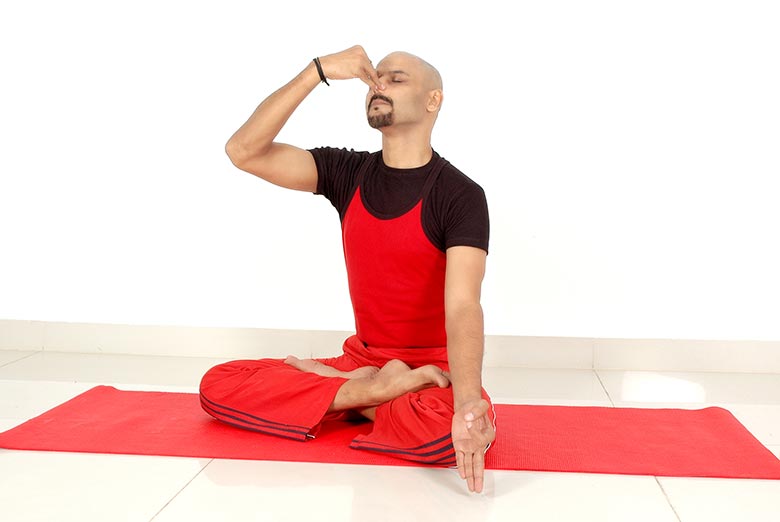
Suryabhedi-pranayama.
Benefits: It heals up the ailments of throats, tongue and voice. It warms our body. It cures many kind of diseases caused by Bile and wind in our Body. Ram Ban for obesity. It destroys the intestinal worms, removes the impurities of blood and cures skin disease. Gastric fire is augmented.
Caution: People suffering from high blood pressure should avoid this Pranayama. Patients of heart and Asthma should practice this Pranayama under the guidance of a yoga guru.

